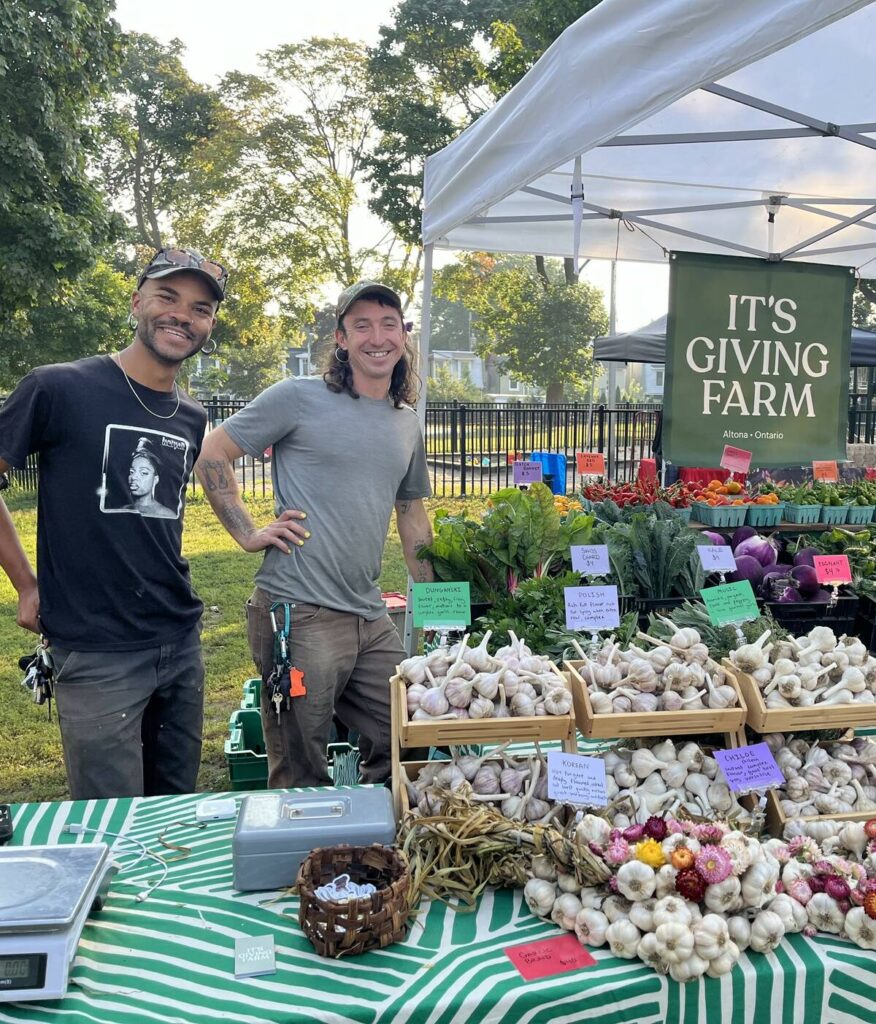Small leaseholders see Rouge National Urban Park as epicentre of farmland preservation

The process of awarding farmland leases inside the Rouge National Urban Park (RNUP) was paused on Jan. 14, as the Parks Canada prepared for the long-awaited official rejection of the Pickering Airport proposal.
Why it matters: The Pickering Airport Lands were expropriated by the federal government in 1972. Much of that land was owned by farmers.
That announcement, which came on Jan. 27, set in motion an ownership transfer from Transport Canada to Parks Canada that will swell the park’s boundaries by thousands of acres – much of it actively farmed by leaseholders.
Read Also


Nick Cowan joins SeCan
SeCan announced that Nick Cowan has joined its team as Marketing Representative for southwestern Ontario. With over three decades of…
Those actively farming the soon-to-be-transferred lands want to know if their leases will be affected, while others hoping to use the RNUP as a springboard into full-time farming are also keenly awaiting updates.
The pre-existing RNUP straddles the boundary between the City of Toronto and Durham Region, covering about 19,000 acres stretching from Lake Ontario to Stouffville. Since its founding in 1995, phased-in transfers have occurred from the province, the Toronto Region Conservation Authority, and two previously-released Transport Canada parcels that were originally part of the 1972 airport proposal.
The Jan. 27 announcement expands that footprint within Durham Region to include “the vast majority” of the remaining 8,700 acres still in Transport Canada hands.
The RNUP website describes the park as “the first federal protected area in Canada to protect agriculture and farming,” adding that “more than 60 farmers tend to roughly 9,000 acres of farmland” within its current boundaries. Wheat, corn and soybeans are listed as the major crops occupying that farmland, but the website offers that “over 30 types of crops” are grown in the park.
There are “over 300 properties in (the park’s) leasing portfolio … rang(ing) from a single field with no assets to properties with a house, outbuildings and fields, or any combination of the three.” The majority, the website states, are currently leased.
In the early 2020s, RNUP stepped away from the established trend of leases to established large-scale cash crop farmers and began offering smaller plots to farmers focusing on innovation, agri-tourism and niche markets.
“Park agriculture will increasingly connect with urban markets desiring local food and rural and agricultural experiences,” stated a 2019 RNUP Management Plan. “Traditional and new farming systems, farm and crop diversification, agri-tourism, connections to urban markets and visitor opportunities will be encouraged.”
To facilitate this transformation, the Management Plan called for “a leasing environment that provides opportunities for economically viable farm operations including the ability to diversify and use innovative farming practices.”
It’s Giving Farm, operated by Fianna Dirks and Ekow Stone, was one of the first successful applicants under the new regime. Dirks and Stone met in 2020 as co-workers on an urban farm in Etobicoke, learned of the RNUP’s call for “expressions of general interest” in available smallholder leases and agreed to apply as partners.
“This was an opportunity for us to own our own farm,” Dirks recalled recently, speaking to Farmtario.
They were invited to view the first set of properties released by Parks Canada in late 2022. Dirks and Stone arrived at the site south of the “ghost village” of Altona to find much of the 12 acres had been left fallow for years, while a pole barn on the property was about to fall down and the house “had been abandoned for a significant amount of time.”
And they fell in love.
The next step was to follow the Parks Canada Request for Proposals (RFP) protocol, which required an intricate business plan, completing an Environmental Farm Plan, and proof the duo had sufficient financial wherewithal to contribute to property improvements. In return for commitments to fix up the house and rebuild agricultural outbuildings, Parks Canada offered a rent abatement formula on a long-term lease.
Dirks believes Parks Canada prefers that leaseholders undertake property improvements because it saves the federal agency from the time-consuming and often costly government protocol of putting out projects to tender.
In January 2023, It’s Giving signed one of the first RNUP agricultural leases under the updated Management Plan. Since then, they’ve continued to work on other GTA farms while preparing the property for move-in. And finally this year, the farm is ready for full operation from its RNUP home.
One by one, a few others have joined It’s Giving and are in various stages of relocating their farming activities to the park. One of those is County Left Farm, operated by Angelina Reesor and Kyle Warren.
Reesor grew up on a farm now located within the RNUP, still operated jointly by her parents and brothers producing cash crops and direct-to-consumer sweet corn. A descendent of Mennonites who came north from Pennsylvania over 200 years ago, she’s a seventh-generation Pickering-area farmer and has been running County Left Farm, producing vegetables mainly sold through farmers’ markets in Toronto on nearby land rented from family friends.
“We have a great tenant/landowner relationship,” she told Farmtario, “but we would never be able to buy the land if it ever came up for sale.”
With six years of farming under their belt, however, and their first child on the way, Reesor and Warren submitted a general interest form to the RNUP in 2023 and were invited to view two properties. Reesor and County Left employee Lara Jerome – a Perth County native with experience on market gardening operations but hoping to one day run her own farm – checked out one property while Warren toured the other.
Reesor and Jerome were disheartened to find a property with a house in significant disrepair. Warren, by contrast, returned to County Left and said, “Angelina, you have to see this other place. It’s beautiful.”
Recalling her first visit to the 40-acre property, Reesor said, “it feels very rural” compared to where they are now, which is “very close to Stouffville, on a busy road with a subdivision going in across the road.” The property within the RNUP, by contrast, “has a long lane, the house is up on a little hill; it’s very private.”
Like Dirks and Stone, despite the property’s drawbacks (including a house, abandoned for approximately two years, full of junk and smelling strongly of cigarettes), Reesor and Warren fell in love.
In June 2024 they signed a 15-year lease with a rent abatement clause recognizing their property upgrade plans, and an understanding it would be extended to 30 years if the farm remains on sound financial footing.
“We had enough business data to show we could be successful,” Reesor said when asked why she believes they were successful through the RFP process.
As of this year, the house remains a renovation zone but the family has moved in. County Left continues to farm on the rented property, with plans to shift some of the growing to the RNUP property in 2026 and full operation within the park in 2027.
Jerome, meanwhile, remains on the outside looking in. She also submitted a general interest form and was invited to view properties. But her submission to the RFP wasn’t selected.
Now, with the Jan. 14 pause on the park’s farmland lease process, she’s unsure about her next chance to apply.
“No one in my family farms anymore,” she said. “I don’t have generational wealth so purchasing land, especially in Ontario, wasn’t an option.”
She describes farmland in the RNUP – along with similarly federally-owned National Capital Commission lands surrounding Ottawa – as among very few avenues in the province for aspiring farmers without access to land to even think about following through on their dreams.
Dirks acknowledges the need for a pause given the imminent transfer of Pickering Airport lands but also hopes Parks Canada uses it as an opportunity to fine-tune the farmland lease protocol so it works better both for those applying and those who have been approved.
“It’s a national park with a focus on agriculture,” Dirks noted. But Parks Canada has never dealt with many things farmers see as routine, such as putting in irrigation ponds or greenhouses. Now, with multiple farms reaching the stage where they’re ready to start production, Parks Canada faces numerous requests for approval of structures and developments.
“And I think that has been a bit overwhelming,” Dirks said.
It’s important the park get things right, Dirks continued.
“It’s a very unique situation because literally on every side of the park are huge subdivisions …The amount of development happening around us is shocking.” Dirks describes the RNUP’s farmland goals, if they get it right within this milieu of rapid urbanization, as “the most dramatic example anywhere of what farmland preservation looks like.”
For anyone who wants to supply the GTA’s dinner tables, meanwhile, making available small parcels of farmland near those consumers is crucial.
“I know so many farmers who are farming precariously in rented land” and several others who have to travel long distances to access the busy farmers’ markets of the GTA, Dirks said. Even with the few RNUP small-scale leases that have been granted so far, “it’s exciting to have more farmers living and working in this area.”
“We’re close enough that we’re able to support each other,” Dirks commented, adding that maybe one day those farmers could establish a Rouge Park farmers’ market.
“The houses are here. The land is here. Obviously, it makes sense that food should be produced in this area. And I hope that, once the (updated) protocol is in place, it can be a speedier process” going from expression of interest to working farm.
Source: Farmtario.com


